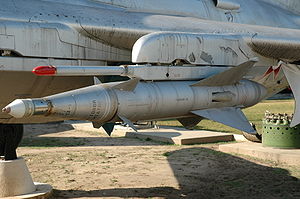Kaliningrad K-5
| K-5 AA-1 Alkali |
|
|---|---|

K-5M
|
|
| Type | short-range air-to-air missile |
| Place of origin | Soviet Union |
| Service history | |
| In service | 1957-1977 |
| Used by | Soviet Air Force |
| Production history | |
| Manufacturer | Kaliningrad Series Production Plant |
| Variants | K-55 |
| Specifications | |
| Weight | 82.7 kg (182 lb) |
| Length | 2.49 m (8 ft 2 in) |
| Diameter | 200 mm (7.9 in) |
| Warhead | High explosive |
| Warhead weight | 13 kg (29 lb) |
|
|
|
| Engine | Rocket |
|
Operational
range |
2 to 6 kilometres (1.2 to 3.7 mi) |
| Speed | 2,880 km/h (1,790 mph) |
|
Guidance
system |
beam riding |
|
Launch
platform |
MiG-17, MiG-19, MiG-21, Su-9 |
The Kaliningrad K-5 (NATO reporting name AA-1 Alkali), also known as RS-1U or product ShM, was an early Soviet air-to-air missile.
The development of the K-5 began in 1951. The first test firings were in 1955. It was tested (but not operationally carried) by the Yakovlev Yak-25. The weapon entered service as the Grushin/Tomashevich (Russian: Грушин/Томашевич) RS-2U (also known as the R-5MS or K-5MS) in 1957. The initial version was matched to the RP-2U (Izumrud-2) radar used on the MiG-17PFU, MiG-19PM. An improved variant, K-5M or RS-2US in PVO service, entered production in 1959, matched to the RP-9/RP-9U (Sapfir) radar of the Sukhoi Su-9. The People's Republic of China developed a copy under the designation PL-1, for use by their J-6B fighters.
The difficulties associated with beam-riding guidance, particularly in a single-seat fighter aircraft, were substantial, making the 'Alkali' primarily a short-range anti-bomber missile. Around 1967 the K-5 was replaced by the K-55 (R-55 in service), which replaced the beam-riding seeker with the semi-active radar homing or infrared seekers of the K-13 (AA-2 'Atoll'). The weapon was 7.8 kg (17 lb) heavier than the K-5, but had a smaller 9.1 kg (20 lb) warhead. The K-55 remained in service through about 1977, probably being retired with the last of the Sukhoi Su-9 interceptors.
...
Wikipedia
